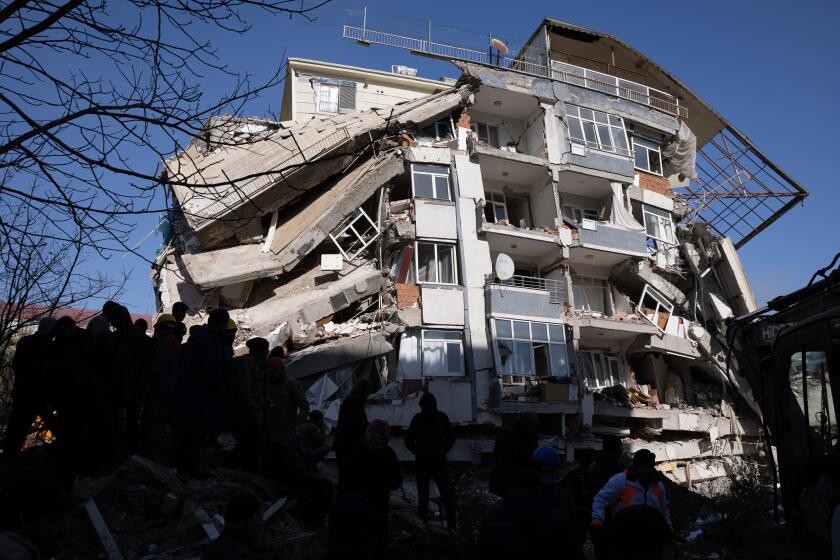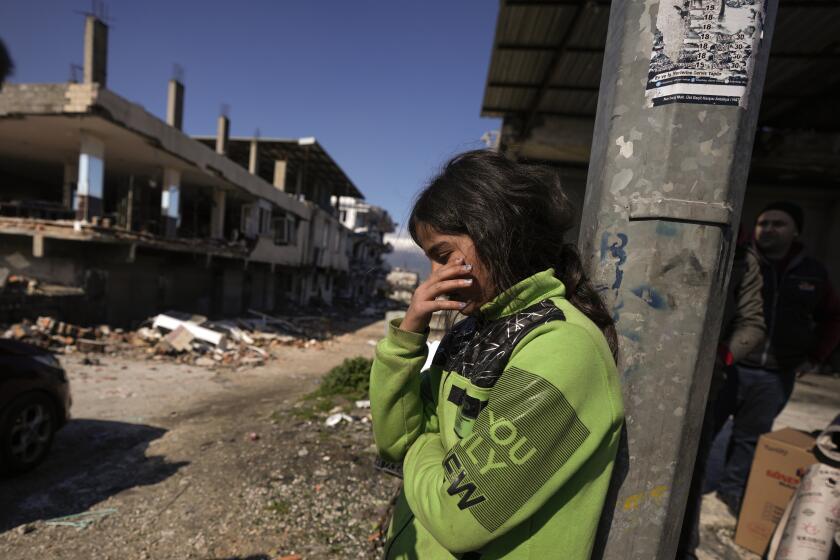If you think the earthquake damage you see in Turkey can’t happen here, think again

- Share via
The images from Turkey and Syria in the last week show us just how devastating a major earthquake can be. When the magnitude 7.8 earthquake we expect on the San Andreas fault happens, we will also see death and destruction, perhaps not as extensive as seen in Turkey, but much worse than most people expect. Rather than the post-earthquake usable buildings many people think are guaranteed by the building code, the current code asks only that our buildings try not to collapse.
Office buildings, hospitals, apartments and homes are only as good as the building code that was in place at the time they were constructed and the degree to which that code was enforced. Problems with enforcement of the code in new construction and the lack of retrofitting of old, bad buildings will contribute to the California death toll when the next big earthquake comes. Efforts to overcome these failures are underway, and we can hope that more is done in time.
But a third, potentially catastrophic flaw in our building code is not being addressed. When it comes to earthquake safety, the current international code is intended solely to keep a building from killing someone while keeping the cost of construction as low as possible.
The catastrophic magnitude 7.8 earthquake that struck Turkey a week ago should be a warning to Californians.
The code essentially says this: You can choose to build a structure that is so weak that it will be a total financial loss after an earthquake, as long as it doesn’t kill someone. Engineers need a more concrete definition for “not killing someone,” and that has become “avoid collapse.”
This rule, called the life safety standard, is really just designed to make the probability of building collapse in an earthquake very low, less than 10% in the worst shaking expected. That sounds good, but put another way it means that no more than 10% of new buildings near a fault are expected to collapse when a big earthquake hits.
This is the code that has been used, if perhaps not fully enforced, in Turkey for the last 20 years. It is also the code in California and most of the United States.
American and Turkish search and rescue teams pull a teenage boy alive from a quake-damaged building in Hatay, Turkey.
Let’s say the code works as planned in California and only a few new buildings collapse in a big earthquake — that doesn’t mean other new buildings won’t be so badly damaged that they will have to be torn down. When Christchurch, New Zealand, experienced a magnitude 6.2 earthquake in 2011 — with shaking that was the maximum expected by its building code — only one modern building (the CTV building, built in 1986) collapsed, killing 115 people, but in addition 1,800 buildings were deemed unrepairable and were demolished. With a collapse rate much lower than 10%, the New Zealand structural engineers had done the job required of them by the code, but do we really think this is an acceptable outcome?
How many times do we need to see devastated cities and towns in other countries before we realize that this could be our future in California, Alaska, Washington, Oregon, Utah, Nevada, Missouri or any of the other seismically active parts of the United States?
Our engineers and scientists have developed standards for a “functional recovery” code — that is, a building code that aims to give us structures that can be repaired after a major temblor, whose function can be recovered. Needless to say, functional recovery is a safer standard for human survival as well as building survival.
Sending money is the best way to help right now, but Americans can also sponsor asylum seekers and visit areas once they’re rebuilt.
Most estimates of the increased cost to build to the functional recovery standard add only about 1% to the cost of construction. An affordable housing complex, Casa Adelante, was just built in San Francisco, and its owners chose to design to a functional recovery standard. It was virtually cost-neutral compared with the original design for a life-safety building.
Two bills in the last five years proposing a statewide functional recovery standard for California have advanced through the Legislature only to eventually fail. We have chosen a future economic catastrophe rather than pay a little more now.
Our elected officials can ensure that we have buildings we can use after the earthquake. We should stop building buildings that may not kill us but that we know will have to be torn down after a big earthquake. Sacramento should give us what most of us thought we already had.
Lucy Jones is the founder of the Dr. Lucy Jones Center for Science and Society and the author of “The Big Ones: How Natural Disasters Have Shaped Us (and What We Can Do About Them).”
More to Read
A cure for the common opinion
Get thought-provoking perspectives with our weekly newsletter.
You may occasionally receive promotional content from the Los Angeles Times.












